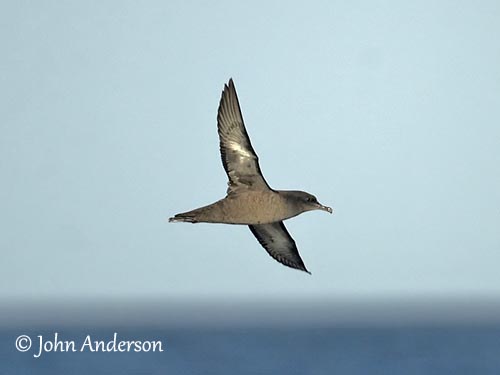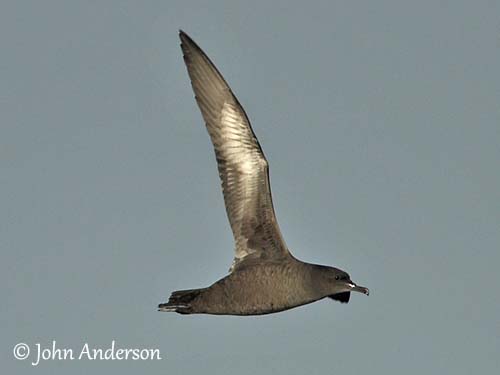
Fr: Puffin fuligineux
Ang: Sooty Shearwater
All: Dunkler Sturmtaucher
Esp: Pardela Sombría
Ita: Berta grigia
Nd: Grauwe Pijlstormvogel
Sd: grålira
Photographers:
John Anderson
John Anderson Photo Galleries
Tom Grey
Tom Grey's Bird Pictures
Simon Tan
PBase Bird galleries
Text by Nicole Bouglouan
Sources:
HANDBOOK OF THE BIRDS OF THE WORLD vol 1 by Josep del Hoyo-Andrew Elliot-Jordi Sargatal - Lynx Edicions - ISBN: 8487334105
A Complete Guide to Antarctic Wildlife by Hadoram Shirihai and Illustrated by Brett Jarrett - Edited by Guy M. Kirwan - ALUL.A Press Oy, Finland - ISBN 9519894705
BirdLife International (BirdLife International)
Department of Sustainability, Environment, Water, Population and Communities
Wikipedia, the free encyclopaedia
Bird Web (Seattle Audubon Society)
New Zealand birds and birding (Narena Olliver)
Ocean Wanderers "Ride the Wave"
What Bird-The ultimate Bird Guide (Mitchell Waite)
Alaska Seabird Information Series
Sooty Shearwater
Ardenna grisea
Procellariiformes Order – Procellariidae Family
INTRODUCTION:
The Sooty Shearwater is a transequatorial migrant and crosses the equator twice a year in order to find food in the best areas and most productive waters.
This species performs a very long migration from the breeding grounds in Antarctic waters to the coastal currents off California, Alaska and Japan in the North.
The Sooty Shearwater’s population is currently declining, and numerous birds are still killed by longline fisheries every year. Harvesting of young birds in S New Zealand, predation by Rattus rattus on their breeding grounds and climate change, are some of the reasons behind the decline of this species.

DESCRIPTION OF THE BIRD:
Biometrics:
Length: 40-46 cm
Wingspan: 94-105 cm
Weight: 650-950 g
The adult is dark with narrow pointed wings showing a conspicuous whitish area on the underwing. The plumage is sooty-brown overall, to dark greyish in fresh plumage, but head, primaries and tail are darker. The scapulars may show scaly pattern.
On the underparts, chin and upperthroat are slightly paler than upperparts, like the rest of underparts form the upperbreast. On the underwing, we can see a white area on most underwing-coverts, whereas the flight feathers are dark greyish with paler primary bases. The axillaries are blackish.
On the dark sooty-brown head, the bill is brownish-grey to dark grey. The eyes are dark brown. Legs and webbed feet are dull pinkish-flesh to greyish, with dusky outer side of tarsus and outer toe.
Male and female are similar.
The juvenile resembles adults.
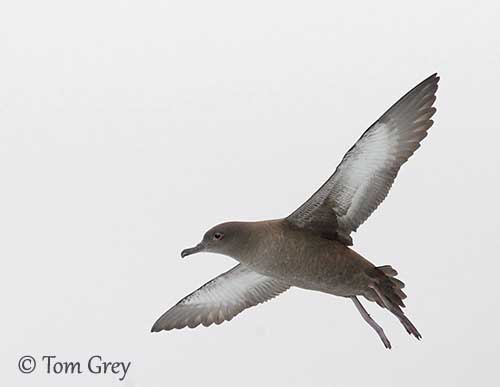
RANGE:
The Sooty Shearwater is one of the most widely distributed seabirds in the world. It breeds in S Chile, Falkland Islands and Tristan da Cunha, but also off SE Australia, New Zealand, and several islands such as Macquarie, Chatham, Antipodes, Campbell, Auckland and Snares Islands.
After breeding, it disperses widely and follows the usual migration routes through E and C pacific and Atlantic Oceans N to Arctic Circle, and Indian Ocean to SE Africa.
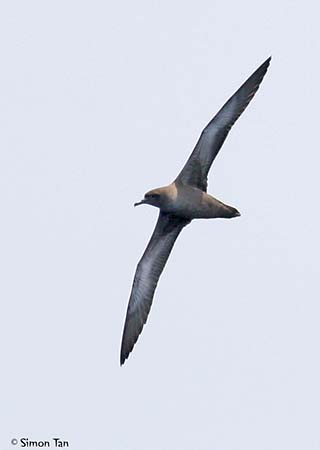
HABITAT:
The Sooty Shearwater is usually found far from land except when breeding. It frequents the open ocean, but concentrations of birds occur over continental shelf in cooler waters, and in the areas where cold and warm waters meet. It can be seen close to land in deep waters.
It breeds on islands and nests in burrows dug in soft soil, or in rock crevices.
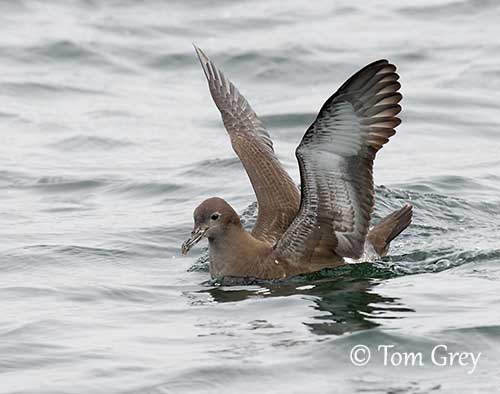
CALLS AND SONGS: SOUNDS BY XENO-CANTO
The Sooty Shearwater is usually silent at sea, but it becomes noisy and vocal at night on the colonies where calls are given by the birds flying over the area.
The usual call is a loud, high-pitched and repeated “coo-roo-ah” uttered by both mates from the burrow and the ground, but we can also hear cat-like howls “wheeoo-har” and hoarse moans “der-rer-ah”.
During the day, they give softer crooning from the burrow, and especially if some movements occur from the surface above the nest.
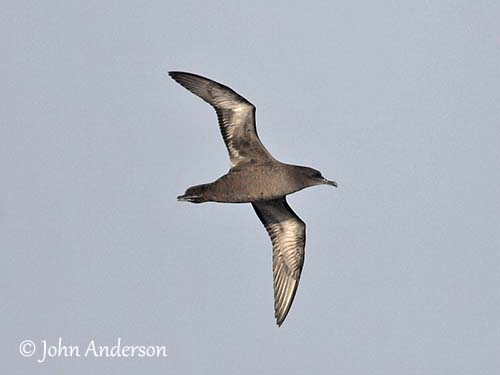
BEHAVIOUR IN THE WILD:
The Sooty Shearwater feeds on cephalopods, small fish and crustaceans. It uses several different techniques such as surface-seizing, surface-diving and pursuit-plunging. It dives from 3-5 metres high while flying and it may reach depths of 30-40 metres, with records at 67 metres. Underwater, it uses the half-opened wings and the webbed feet to propel itself.
Large flocks often gather at abundant food sources such as crustaceans or small fish. They feed with other seabird species and in association with cetaceans. After feeding, extensive rafts of birds can be seen resting on the water.
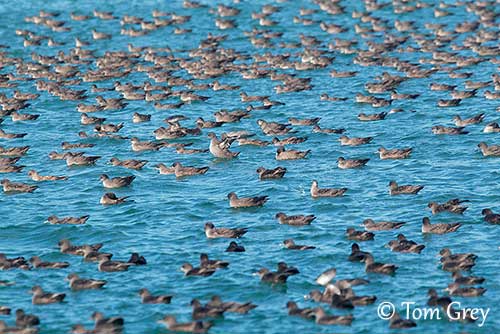
At the beginning of the breeding season, the Sooty Shearwater becomes noisy and busy as the birds clean out the burrows and perform some courtship displays. The entrance of the burrow is defended against other birds and intruders in the dense colonies.
They are monogamous with long-term pair-bonds, although the pair-bond may also last only one season. They arrive and leave the colonies at night and noisily. They usually return to the same site year after year, and often with the same mate.
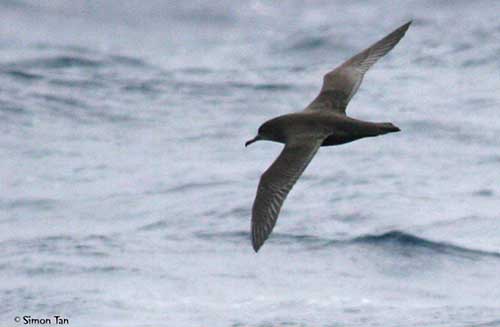
The Sooty Shearwater leaves the colonies after breeding and migrates into N Pacific and N Atlantic. The non-breeding birds leave first, and then the breeding birds leave in mid-April, while the young birds follow the adults about one month later.
Numerous birds head first into NW sector of respective oceans, and then, they move E by following the prevailing winds to reach the W coasts of North America and Europe during the local summer. Some birds may remain in Southern Ocean over winter. The others return from late August to early December.
The Sooty Shearwater flies low over water in calm weather, with rapid, stiff wingbeats. In windy weather, it glides and scales easily over the waves.
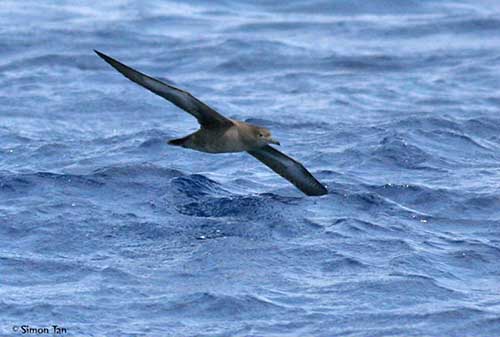
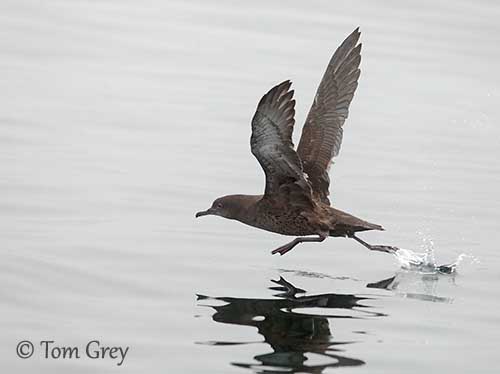
REPRODUCTION OF THIS SPECIES:
The breeding season starts in late September/early October. The return to the breeding grounds is followed by two weeks of pre-laying exodus.
The Sooty Shearwater nests in self-excavated burrow of 30 centimetres to 3 metres long, lined with some vegetation. It also uses cavities and rock crevices on vegetated slopes, usually on offshore islands. It shares the breeding grounds with several other petrel species.
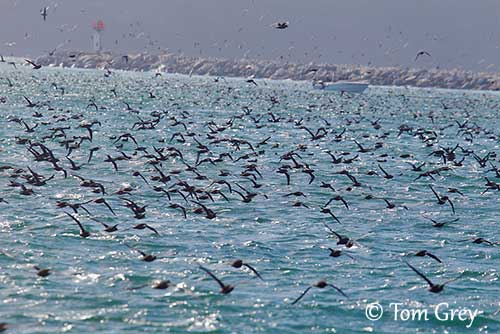
The female lays a single white egg. Both adults incubate during 52-56 days with stints of 4-9 days. At hatching, the chick has greyish down but the underparts are paler.
It is brooded during the first 5 days and both parents feed it at night with frequent visits during the first days, and less often as the chick is growing up. It fledges about 97 days after hatching and usually departs from the island at night.
This species produces a single brood per season.
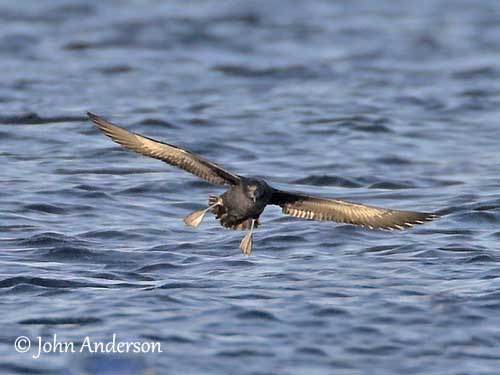
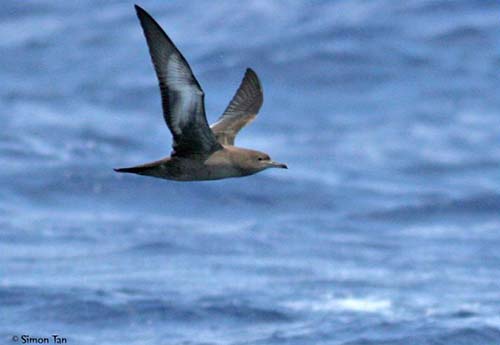
PROTECTION / THREATS / STATUS:
The Sooty Shearwater has wide range where it is abundant and widespread, with a population estimated to number 20,000,000 individuals. However, the population is declining due to several threats including harvesting young birds (about 250,000 young birds per year), longline fisheries involve large numbers of dead birds (including other seabird species), climate change involving reduction of preys, and predation by rats (Rattus rattus) which take eggs and chicks.
Some breeding sites are now protected, and introduced predators have been eradicated from several islands.
But currently, the Sooty Shearwater is classified as Near Threatened.
